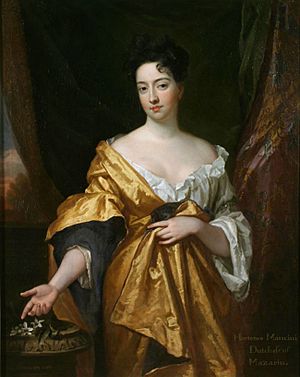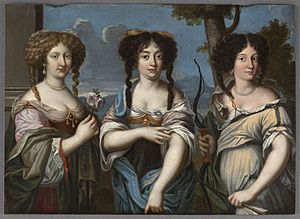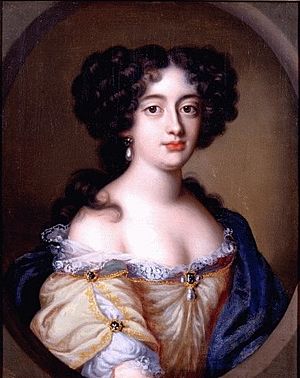Hortense Mancini facts for kids
Quick facts for kids Hortense Mancini |
|||||
|---|---|---|---|---|---|
| Duchess of La Meilleraye suo jure Duchess of Mazarin |
|||||

Portrait by Sir Godfrey Kneller c. 1671
|
|||||
| Born | 6 June 1646 Rome, Papal States |
||||
| Died | 2 July 1699 (aged 53) | ||||
| Spouse |
Armand Charles de La Porte de La Meilleraye
(m. 1661; sep. 1668) |
||||
| Issue | Marie Charlotte, Duchess of Aiguillon Marie Olympe, Marquise of Bellefonds Paul Jules, 3rd Duke of La Meilleraye |
||||
|
|||||
| Father | Lorenzo Mancini | ||||
| Mother | Girolama Mazzarini | ||||
Hortense Mancini, Duchess of Mazarin (6 June 1646 – 2 July 1699), was a niece of Cardinal Mazarin, chief minister of France, and a mistress of Charles II, King of England, Scotland, and Ireland. She was the fourth of the five famous Mancini sisters, who, along with two of their female Martinozzi cousins, were known at the court of King Louis XIV of France as the Mazarinettes.
Contents
Early life, family and marriage
One of five sisters noted for their great beauty, she was born Ortensia in Rome to Baron Lorenzo Mancini, an Italian aristocrat. After his death in 1650, her mother, Girolama Mazzarini, brought her daughters from Rome to Paris in the hope of using the influence of her brother, Cardinal Mazarin, to gain them advantageous marriages. Hortense's four famous sisters were:
- Laura (1636–1657), who married Louis de Bourbon, duc de Vendôme and became the mother of the famous French general Louis Joseph de Bourbon, duc de Vendôme,
- Olympe (1638–1708), who married Prince Eugène-Maurice of Savoy-Carignano and became the mother of the famous Austrian general Prince Eugene of Savoy,
- Marie (1639–1715), who married Prince Lorenzo Onofrio Colonna and was the first romantic love of King Louis XIV of France,
- Marie Anne (1649–1714), who married Godefroy Maurice de La Tour d'Auvergne, Duke of Bouillon, a nephew of the famous field marshal Turenne.
The sisters' cousins, the Martinozzis, also moved to France at the same time, for the same goal (to marry well). The elder, Anne Marie Martinozzi, married Armand de Bourbon, Prince de Conti. The younger, Laura, married Alfonso IV d'Este, duke of Modena and became the mother of Mary of Modena, second wife of James II of England.
The Mancinis also had three brothers: Paul (twin brother to Laura) Philippe, and Alphonse.
Marriage proposals
Charles II of England, the first cousin of Louis XIV, proposed to Hortense in 1659, but his offer was rejected by Cardinal Mazarin who believed the exiled king to have little in the way of prospects. Mazarin realised his mistake when Charles was reinstated as King of England only months later. Mazarin then became the supplicant and offered a dowry of 5 million livres, but Charles refused. While a marriage did not materialise, the two were to cross paths later. Hortense's hand was also requested by Charles Emmanuel II, Duke of Savoy, another first cousin of Louis XIV, but arrangements fell through when Cardinal Mazarin refused to include the stronghold-castle of Pignerol in her dowry. For similar reasons, an offer made by the Duke of Lorraine was broken off as well.
Failed marriage
On 1 March 1661, fourteen-year-old Hortense was married to one of the richest men in Europe, Armand Charles de La Porte de La Meilleraye. Upon marriage to Hortense, he was granted the title of duc Mazarin. On the death of Cardinal Mazarin soon after, he gained access to his wife's huge inheritance, which included the Palais Mazarin in Paris, home to many pieces of fine art.
The marriage was not a success. Hortense was young, bright, and popular; Armand-Charles was miserly and extremely jealous, not to mention mentally unstable. He forbade his wife to keep company with other men, insisted she spend a quarter of her day at prayer, and forced her to leave Paris and move with him to the country.
Despite their differences, Hortense and her husband had four children:
- Marie Charlotte de La Porte (28 March 1662 – 13 May 1729) married Louis Armand de Vignerot du Plessis, duc d'Aiguillon,
- Marie Anne de La Porte (1663 – October 1720) became an abbess,
- Marie Olympe de La Porte (1665 – 24 January 1754), who married Louis Christophe Gigault, Marquis of Bellefonds and of Boullaye,
- Paul Jules de La Porte de La Meilleraye (25 January 1666 – 7 September 1731) married Félice Armande Charlotte de Durfort.
Flight from marriage
Leaving her small children behind, Hortense finally made a bid to escape from her marriage on the night of 13 June 1668, with help from her brother, Philippe, Duc de Nevers, who procured horses and an escort to help her travel to Rome, where she counted on being able to take refuge with her sister Marie Mancini, now the Princess Colonna.
Under the protection of Louis XIV and of the Duke of Savoy
The French king Louis XIV declared himself her protector and granted an annual pension of 24 thousand livres. Her former suitor, Charles Emmanuel II, Duke of Savoy, also declared himself her protector. As a result, Hortense retired to Chambéry in Savoie and established her home as a meeting place for authors, philosophers, and artists. After the death of the duke, though, she was turned out by his widow, Marie Jeanne Baptiste of Savoy-Nemours.
With the exception of Marguerite de Valois, Hortense and her sister, Marie Mancini, were the first women in France to put their memoirs into print. Both women were partly motivated by the help that producing a body of evidence would bring to the cause of separation from their abusive husbands. Their Memoirs were first published in French, but Hortense Mancini's were translated into English by 1676.
Charles II
After the death of Savoy, Hortense had no source of income; her husband froze all of her income, including the pension from Louis XIV.
The English ambassador to France, Ralph Montagu, aware of Hortense's desperate situation, enlisted her help in increasing his own standing with Charles II. He hoped she would replace the king's current mistress, Louise de Kerouaille, Duchess of Portsmouth. Hortense was willing to try. In 1675, she travelled to London under the pretext of a visit to her young niece, Mary of Modena, the new wife of Charles II's younger brother, James, Duke of York. The publication of an English translation of her Memoirs had made her known to English society prior to her arrival.
By mid-1676, Hortense had taken the place of Louise de Kerouaille in Charles's affections. He provided her a pension of £4,000, which considerably lightened her financial troubles.
When Mancini fell from favour, Charles cut off her pension. This signified the end of Hortense's position as the king's favourite. Hortense, however, maintained good relations with the king until his death.
After Charles II's death

Following the death of Charles II, Hortense was well-provided for by James II, possibly because of her kinship with James's wife, the new queen, Mary of Modena. Even when James fled England and William III and Mary II came to power, she remained in place, albeit with a much-reduced pension. During this time she presided over a salon of intellectuals. It was considered one of the most celebrated salons in seventeenth century Europe. Charles de Saint-Évremond, the great poet and epicurean, was a close friend and brought to her door all the learned men of London. In addition women attended, including Nell Gwyn, Barbara Villiers and Louise de Kéroualle. Champagne made its first appearance in English society as a fashionable drink. Women were able to gamble and also mix with playwrights, theologians and scientists to talk about current events and ideas.
She died on June 11th, 1699. Her husband managed to continue the drama after her death; he carted her body around with him on his travels in France, before finally allowing it to be interred by the tomb of her uncle, Cardinal Mazarin.
Descendants
Hortense's son, Paul Jules de La Porte, duc Mazarin et de La Meilleraye, had two surviving children. His daughter, Armande Félice de La Porte Mazarin (1691–1729), married Louis de Mailly, marquis de Nesle et de Mailly, Prince d'Orange in 1709. Through this marriage, she became the mother of five daughters, four of whom would become mistresses of King Louis XV of France:
- Louise Julie de Mailly, Mademoiselle de Mailly, comtesse de Mailly (1710–1751)
- Pauline Félicité de Mailly, Mademoiselle de Nesle, marquise de Vintimille (1712–1741)
- Diane Adélaïde de Mailly, Mademoiselle de Montcavrel, duchesse de Lauraguais (1714–1769)
- Hortense Félicité de Mailly, Mademoiselle de Chalon, marquise de Flavacourt (1715–1763)
- Marie Anne de Mailly, Mademoiselle de Monchy, marquise de La Tournelle, duchesse de Châteauroux (1717–1744)
The only one of the de Nesle sisters not to become one of Louis XV's mistresses was the marquise de Flavacourt. Louise Julie was the first sister to attract the king, followed by Pauline Félicité, but it was Marie Anne, the youngest and prettiest one, who was the most successful in manipulating him and becoming politically powerful.
Armande Félice also had an illegitimate daughter, Henriette de Bourbon (1725–1780), Mademoiselle de Verneuil, from her relationship with the duc de Bourbon, the chief minister of Louis XV from 1723 to 1726.
Paul Jules' son, Guy Jules Paul de La Porte, duc Mazarin et de La Meilleraye (1701–1738), married Louise Françoise de Rohan in 1716. Their great-granddaughter, Louise Félicité Victoire d'Aumont, duchesse Mazarin et de La Meilleraye (1759–1826), married Honoré IV, Prince of Monaco in 1777. From this marriage, the present Sovereign Princes of Monaco, including Prince Albert II of Monaco, are descended.
See also
 In Spanish: Hortensia Mancini para niños
In Spanish: Hortensia Mancini para niños



